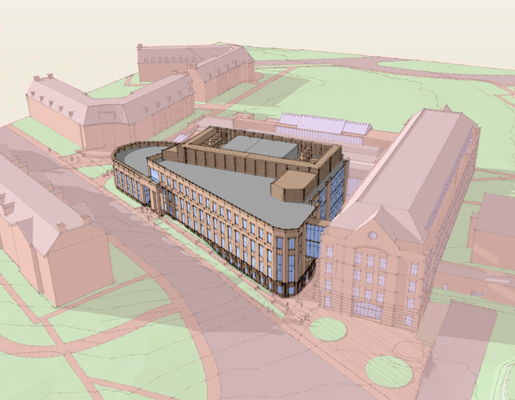Phase 3
The new building will complete the integrated science concept
Members of the Committee on Buildings and Grounds of William & Mary’s Board of Visitors were treated to an advance look at the Machine for Science and other features of Phase 3 of the College’s Integrated Science Center.
Anna Martin, the College’s vice president of administration, unveiled artist’s conceptions of ISC 3 at the committee’s meeting this week. This third phase will complete the triangle started by the first two phases of the Integrated Science Center, which have been in operation for several years. Funding for the $85 million facility will be provided by the Commonwealth of Virginia.
Randy Strickland, the College’s project manager for ISC 3, says that the building will be four stories tall and add 113,000 square feet to the Integrated Science Center complex. The project also will add a greenhouse to the top of ISC 2 (old Rogers Hall), while the Barksdale Field side of the façade of ISC 2 will be redone to complement the exteriors of ISC 1 and ISC 3.
Dennis Manos, vice provost for research, says the construction of ISC 3 will complete the integrated science concept initiated by the first two phases. The integrated science concept hinges on the strategic housing of researchers and siting of resources to promote fruitful interdepartmental collaborations as well as to maximize shared access to expensive scientific instruments. The concept also includes design of flexible laboratories, creating space that could be easily transformed to suit the requirements of various scientific disciplines.
New focal point of applied science
Manos said the new building will be the new focal point for research done by William & Mary’s researchers in applied science, who now are located in McGlothlin-Street Hall. In recognition of the growing importance of computation in addressing the most advanced problems of science, the ISC 3 will have a strong computational component and will house SciClone, the College’s research and science computer cluster now located in Jones Hall. Manos says that relocation of the computer servers to ISC 3 has a couple of advantages.
“When you generate a big set of data from a long calculation, you don’t want to have to pick it up and send it down a low-bandwidth channel to a building far away for further analysis or display. We like to have all of that in one place,” he said. “The other advantage is a cultural shift.”
Manos explained that the cultural shift will arise from the computational people working in the same building with other scientists in the Integrated Science Center.
“If you’re working on a problem that involves several terabytes of data, the natural thing would be to think about how you’re going to crunch it, how you’re going to interpret it, how you’re going to display it,” he said. “Having mathematicians and computer scientists—the modeling and simulation people—right down the hall from you will help you do that job.”
Large neuroscience presence
ISC 3 also will contain “a large neuroscience presence,” Manos said. Neuroscience has become one of the most fruitful interdepartmental programs at William & Mary. Consolidation of lab space for many of the College’s neuroscience researchers, who are based in several academic departments, was an unfinished component of the first two ISC phases. Manos noted that, among other things, bringing applied science researchers into the ISC will essentially complete the consolidation of neuroscience.
“The ISC is designed to keep STEM as aggressively active on this campus as it always has been—or more so,” Manos said. “So think of ISC 3 as the final step of bolting the engine into a car, driving a very heavy emphasis on science, technology, engineering and math. I think the cluster we put together does that.”
The ISC will be built around a four-story core that the architects are calling the Machine for Science. The Machine for Science will contain major laboratories, facilities for materials processing, lasers and microscopy, along with shared instrumentation.
The Machine for Science
“It’s a large interior box-shaped structure in the center of the building,” Manos said. “The Machine for Science will be the location of the thumping heart of the science that will occupy this building. Around that periphery, surrounding this four-story core, there will be everything else.”
Strickland explains that “everything else” includes office space for the scientists. In addition, a 300-seat lecture hall will replace the College’s present largest lecture hall, Millington 150. Adjacent to the lecture hall will be a two-story commons area with a coffee/snack bar.
Funding for the project was authorized by the Commonwealth
as part of the state's 2011-12 biennium capital construction budget. The
architectural firm EYP is now working on the schematic design of the building.
Construction on ISC 3 is expected to begin in 2014. A timeline for construction
will be drawn up after plans are submitted to Commonwealth officials in fall,
2012. ![]()















